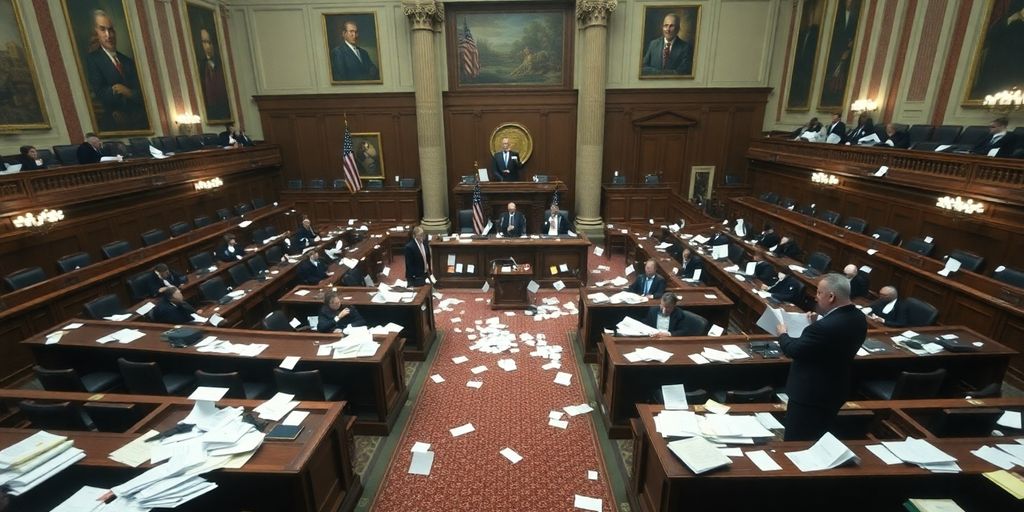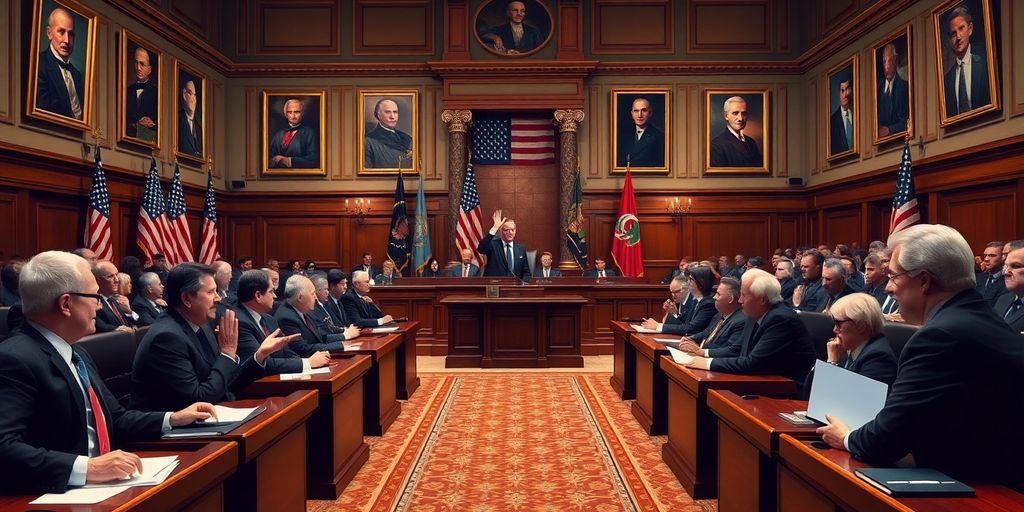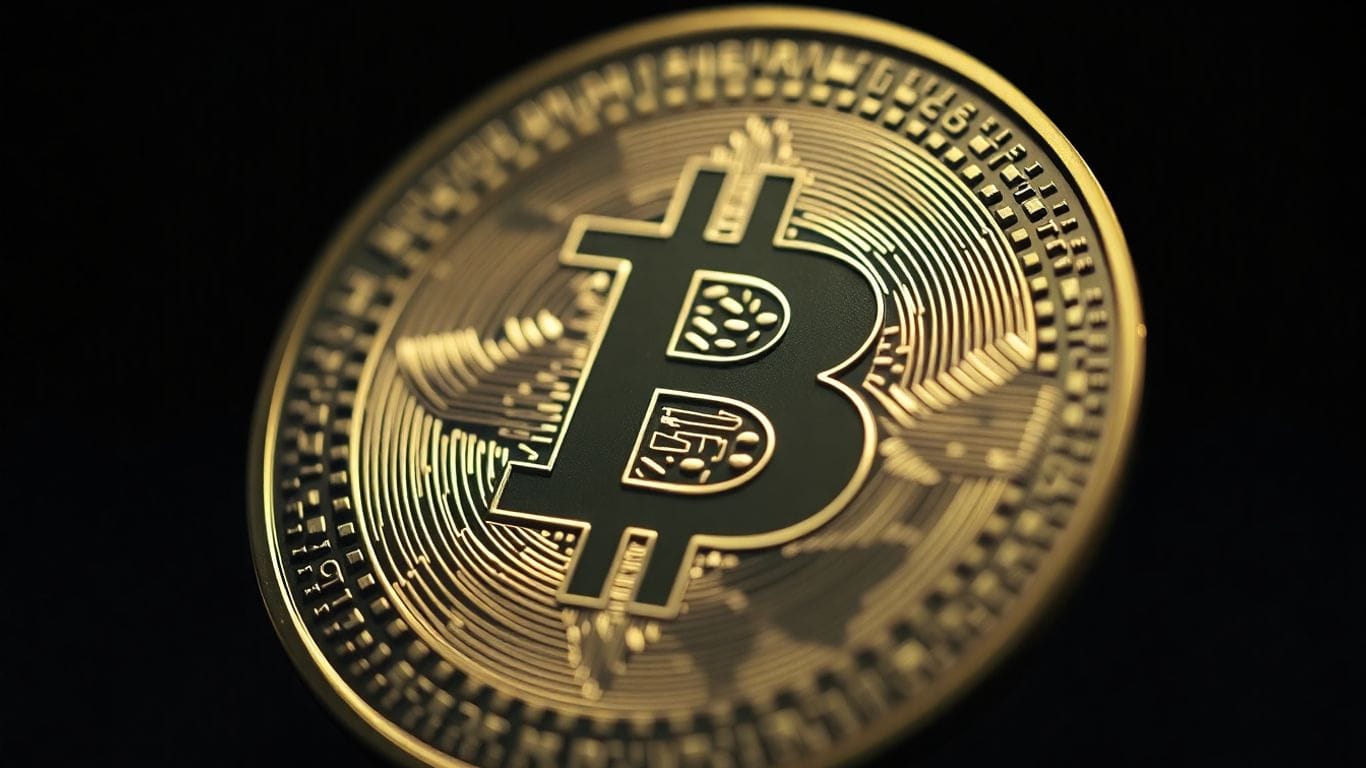All About The Crypto Bill
So, the big news is that the US has finally passed its first major crypto law. It's called the GENIUS Act and it's all about stablecoins. This is a pretty big deal for the whole digital currency world, which has been asking for clearer rules for a while now. President Trump is expected to sign it soon, and it seems like a pretty significant shift in how the US is looking at crypto.
Key Takeaways
- The GENIUS Act establishes the first national regulatory framework for stablecoins in the U.S., requiring them to be backed by reserves like U.S. dollars or Treasuries.
- Supporters believe this crypto bill will strengthen the U.S. dollar's global standing and attract digital asset activity to the country.
- The legislation includes consumer protection measures, such as requiring issuers to hold 100% reserves and disclose holdings, and prohibits misleading claims about government backing.
- While the bill has support from industry groups and some lawmakers, critics argue the regulations might not be strict enough and could introduce new financial risks.
- President Trump has been a vocal proponent of the crypto bill, aiming to position the U.S. as a leader in digital assets, though concerns exist about potential conflicts of interest due to his family's involvement in a crypto company.
Understanding The Crypto Bill

The GENIUS Act: A New Regulatory Framework
The GENIUS Act represents a significant step in establishing a formal regulatory structure for digital assets within the United States. This legislation is particularly focused on a specific type of cryptocurrency known as stablecoins. The core idea behind stablecoins is that their value is pegged to a more stable asset, often the U.S. dollar. This peg is typically maintained by the issuer holding reserves equivalent to the value of the stablecoins in circulation. The GENIUS Act aims to bring clarity and stability to this burgeoning market by setting clear rules for their issuance and management. This new framework is designed to prevent the kind of market volatility that has sometimes affected the broader crypto space, as seen in recent downturns where leveraged positions were wiped out [1695].
Stablecoins: The Focus of New Legislation
Stablecoins have become a key area of interest for regulators due to their unique characteristics and growing use in digital asset transactions. Unlike more volatile cryptocurrencies like Bitcoin, stablecoins are designed to maintain a consistent value. The GENIUS Act mandates that issuers of stablecoins must hold reserves that fully back the tokens they issue, typically on a one-to-one basis with U.S. dollars or other low-risk assets. This requirement is intended to ensure that users can redeem their stablecoins for the underlying asset without issue, providing a layer of security. The bill's focus on stablecoins reflects their role as a bridge between traditional finance and the digital asset world, facilitating transfers and acting as a store of value within crypto ecosystems. Major financial players are also showing increased interest, with significant investments being made in assets like Ethereum [4722].
Key Provisions of The Crypto Bill
The legislation introduces several key provisions aimed at regulating the digital asset market. Primarily, it sets standards for stablecoin issuers, requiring them to maintain adequate reserves and undergo regular audits. This is a direct response to concerns about the stability and transparency of some stablecoin projects. The bill also addresses the classification of digital assets, distinguishing between those that might be considered securities and those that are more akin to commodities [6b3c]. This classification has important implications for how these assets are treated under existing financial laws and for tax purposes. Furthermore, the act seeks to clarify the roles of different regulatory bodies, such as the Securities and Exchange Commission (SEC) and the Commodity Futures Trading Commission (CFTC), in overseeing digital currency activities [b01c].
It's important for anyone involved in the crypto space to understand these new rules. Here are some key takeaways:
- Reserve Requirements: Stablecoin issuers must hold reserves equal to the value of issued tokens.
- Oversight Clarity: The bill aims to define which agencies regulate different types of digital assets.
- Market Stability: Provisions are in place to reduce volatility associated with stablecoins.
The passage of this bill is seen by many as a landmark moment for the cryptocurrency industry in the U.S., potentially paving the way for greater mainstream adoption and innovation. However, critics have raised concerns about whether the protections are sufficient for consumers and the broader financial system.
Impact and Implications of The Crypto Bill
So, the big crypto bill finally made it through Congress. It’s a pretty significant moment for the digital asset world, and it’s going to change how things work, at least for stablecoins.
Strengthening The U.S. Dollar's Reserve Status
One of the main points of this new legislation is how it deals with stablecoins. These are a type of cryptocurrency that's supposed to be pegged to something stable, like the U.S. dollar. The bill basically says that companies issuing these stablecoins have to hold actual dollars, or something equally safe, to back them up. Think of it like this: if you buy a stablecoin that's supposed to be worth one dollar, the company that issued it has to have one dollar sitting in a vault somewhere. This is meant to make them more reliable and prevent the kind of chaos you might see if a company suddenly can't pay people back. This move is seen by many as a way to keep the U.S. dollar strong in the face of new digital money. It’s a big deal because it means the U.S. is trying to set the rules for this new financial space, rather than letting other countries or private companies do it all. It’s also interesting to see how this might affect things like international payments, making them potentially faster and cheaper than traditional methods like wire transfers. We're already seeing companies like Stripe and Coinbase working on ways to use stablecoins for everyday purchases, which could really change how we shop online. See how companies are adopting
Attracting Digital Asset Activity to the U.S.
With these new rules in place, the hope is that the U.S. will become a more attractive place for crypto businesses to set up shop. Before, it was a bit of a Wild West, with unclear regulations. Now, there’s a clearer path forward, which could bring more innovation and investment into the country. It’s like building a better road system; it makes it easier for people to travel and do business. Some people think this could even lead to more companies holding digital assets, similar to how Coinbase has been increasing its Bitcoin reserves. Coinbase's growing holdings show a trend of major players taking digital assets more seriously. The idea is that by providing a stable regulatory environment, the U.S. can capture a larger share of the global digital asset market, rather than having businesses and talent move elsewhere. This could also mean more opportunities for U.S. consumers to interact with digital assets safely.
Consumer Protection Measures in The Bill
While some critics worry the bill doesn't go far enough, there are definitely measures aimed at protecting consumers. The requirement for stablecoin issuers to hold reserves is a big one. It means that if you own a stablecoin, there’s a better chance you can get your money back when you want it. The bill also includes rules about preventing money laundering and making sure companies are upfront about their dealings. This is important because, let's be honest, crypto has had a bit of a reputation problem with illicit activities.
The legislation aims to bring more order to the digital asset space, making it safer for everyday people to use and invest in cryptocurrencies.
There are also anti-money laundering rules included, which are designed to stop criminals from using digital assets for illegal purposes. It’s all about trying to build trust in the system. The goal is to make sure that as digital assets become more common, people aren't left vulnerable to scams or fraud. This is a big step, but it's also just the beginning, and more regulations are likely to come as the technology keeps changing. More crypto regulations are expected
Support and Opposition to The Crypto Bill

Industry Support and Lobbying Efforts
Industry groups lined up early, framing the bill as basic plumbing for payments. Trade associations, exchanges, wallet firms, and a few big retailers pushed hard, saying clear rules would move crypto from hype to real-world use. A Senate Banking effort to build a cross-aisle path, led by Senator Tim Scott, gave supporters a talking point that this wasn’t just a niche fight.
- Who showed up: crypto companies, payment processors, some banks, and retailers tired of card fees.
- Core message: set guardrails for stablecoins so they can function like cash online, without blowing up bank-style.
- Tactics: policy papers, district-level meetings, campaign spending, and “jobs and innovation” roadshows.
- What they wanted: 1:1 reserves, regular disclosures, clear state–federal roles, and a route to federally supervised issuance.
- Why now: firms argue the U.S. is lagging; if the rules stay fuzzy, they say activity and talent go abroad.
Supporters also pointed to payment use cases—faster settlements, fewer chargebacks, cheaper remittances—and argued that clarity would pull more activity into regulated channels instead of offshore venues.
Concerns Raised by Critics
Opponents aren’t buying the “payments reform” pitch. They see new risks for households and the broader system if reserves, governance, and bankruptcy treatment aren’t airtight.
- Misplaced trust: people may assume every token is safe, then learn the hard way what’s actually backing it.
- Run risk: even with reserves, disorderly redemptions can trigger fire sales that spill into money markets.
- Big Tech creep: platforms could launch quasi-bank products without bank-level oversight.
- Anti-abuse gaps: laundering, sanctions evasion, and ransomware remain live issues if compliance is spotty.
- Consumer recourse: if an issuer fails, who gets paid first—and how fast—still worries advocates.
- Data use: wallet and transaction data could be mined for ads or profiling unless privacy limits are explicit.
Critics warn that passing a light-touch framework could make risky instruments look safe and push losses onto ordinary users.
Many also flag preemption fights: if federal rules crowd out tougher state standards, the floor might become the ceiling.
Bipartisan Support for The Legislation
Both parties gave the bill some oxygen, but not for the same reasons. Support spans both parties, but for different reasons.
- Republican rationale: keep payments innovation in the U.S., block a central bank digital currency, and strengthen dollar reach in private digital rails.
- Democratic rationale (supporters): get transparency, audits, and AML rules on the books rather than letting the market run on vibes.
- Holdouts in both parties: worry about consumer protection, tech concentration, and whether the supervisory home is strong enough.
Some moderates argue that a workable baseline beats regulatory limbo, even if they want upgrades later (like tougher governance, stress tests, and tighter commingling bans). The broader market backdrop—rising institutional interest and busy token markets—also added pressure to “do something” rather than punt again, as seen in recent institutional activity trends.
The Role of President Trump and Administration

President Trump has been a significant figure in the push for the GENIUS Act, often stating his desire to make the United States the global leader in digital assets. He has publicly supported the bill, calling it "pure GENIUS!" and emphasizing its potential for massive investment and innovation within the country. His administration's actions have been geared towards positioning the U.S. advantageously in the evolving digital asset landscape.
President Trump's Stance on Digital Assets
President Trump has consistently voiced support for cryptocurrencies, seeing them as a key area for future economic growth and technological advancement. He has expressed a vision for America to dominate this sector, aiming to attract significant investment and drive innovation. This proactive stance has been a driving force behind the legislative efforts.
Fulfilling Campaign Promises on Crypto
Making America the "crypto capital of the world" was a stated goal during President Trump's campaign. The passage of the GENIUS Act is seen as a direct fulfillment of this promise. The legislation aims to create a clear regulatory environment that encourages responsible development and adoption of digital assets, thereby boosting the U.S. economy and its technological standing.
Executive Actions Supporting Digital Assets
Beyond legislative support, President Trump has also taken executive action to bolster the U.S. position in digital assets. Early in his term, an executive order was signed to promote U.S. leadership in this area. Furthermore, actions establishing a Strategic Bitcoin Reserve and a U.S. Digital Asset Stockpile were taken, signaling a strategic government approach to digital currency. This move was intended to place the United States at the forefront of national digital asset strategy, aligning with his broader economic policies. The GENIUS Act, which focuses on stablecoins, was signed into law, establishing a framework for managing these digital assets and introducing new regulations for them.
Here's a look at some key aspects of the administration's approach:
- Promoting U.S. Leadership: Executive orders aimed at establishing the U.S. as a dominant force in digital assets.
- Strategic Reserves: Creation of reserves to position the nation advantageously in the digital asset market.
- Legislative Endorsement: Strong backing for bills like the GENIUS Act to create a clear regulatory path.
The administration's focus has been on harnessing the potential of digital assets for economic growth while establishing clear rules to manage risks and protect consumers. This dual approach seeks to balance innovation with stability.
President Trump's involvement was instrumental in the bill's passage, particularly in uniting lawmakers behind the legislation. His administration's efforts have been central to shaping the current regulatory landscape for digital assets.
Addressing Illicit Activity and National Security
Combating Illicit Activity in Digital Assets
This new crypto bill puts a spotlight on how digital assets can be used for less-than-legal purposes. The legislation aims to make it harder for bad actors to use cryptocurrencies for things like money laundering or funding illegal operations. It's a big step towards making the digital asset space safer for everyone. By setting clear rules, the government hopes to cut down on the use of crypto in criminal activities. This includes making sure that companies dealing with stablecoins have systems in place to flag suspicious transactions. It’s all about bringing more accountability to the digital currency world.
Anti-Money Laundering and Sanctions Compliance
One of the main points of the bill is to make sure stablecoin issuers follow the same anti-money laundering (AML) and sanctions rules that traditional financial institutions do. This means these companies will have to:
- Register with the government and get approval.
- Put in place programs to check customer identities.
- Monitor transactions for any signs of illegal activity.
- Report suspicious activities to the authorities.
This move is designed to prevent illicit funds from flowing through the digital asset ecosystem. It’s a direct response to concerns that cryptocurrencies could be exploited to bypass existing financial regulations. The goal is to make sure that the U.S. dollar's strength isn't undermined by unregulated digital currencies. The bill also requires stablecoin issuers to have the technical ability to freeze or block transactions if legally required, adding another layer of control. This is a significant change for the industry, pushing it towards greater transparency and compliance, much like what you see with traditional banking services.
Coordination with Treasury Department
The bill emphasizes strong cooperation between regulatory bodies and the Treasury Department. This partnership is key to effectively enforcing sanctions and combating financial crimes. The Treasury Department will have enhanced capabilities to track and stop money laundering activities involving digital assets. This collaboration is expected to improve the government's ability to enforce sanctions against individuals and groups who might try to use cryptocurrencies to evade international restrictions. It’s a coordinated effort to keep the U.S. financial system secure. The idea is that by working together, these agencies can better identify and disrupt illicit financial flows, protecting national security interests. This approach aligns with broader efforts to modernize financial regulations for the digital age, making sure that the U.S. remains a leader in financial innovation while also maintaining security. The focus on stablecoins, in particular, is seen as a way to manage risks associated with new forms of digital money, potentially attracting more digital asset activity to the U.S. by providing a clear regulatory path for businesses.
Future of Crypto Regulation Following The Bill

So, the big crypto bill, the GENIUS Act, is heading to the president's desk. This is a pretty big deal, marking the first national legislation specifically for digital assets in the U.S. It really sets the stage for what comes next. Think of it as the first step, not the last one, in figuring out how crypto fits into our financial world.
Further Legislation Expected in Congress
While the GENIUS Act focuses on stablecoins, it's pretty clear that Congress isn't stopping there. There are other bills floating around, like one that aims to clarify which government agencies will be in charge of different parts of the crypto space. Another one is about whether the U.S. should even consider creating its own digital dollar. These still need to get through the Senate, so it's not a done deal yet, but it shows there's more on the table.
Regulatory Oversight for Digital Currency
This new bill means stablecoins, which are a type of crypto backed by assets like the U.S. dollar, will have clearer rules. Issuers will need to hold reserves, dollar for dollar, for every stablecoin they put out. This is meant to make them more reliable when people want to cash them in. It's a move towards making digital currency transactions smoother and potentially cheaper than traditional methods like wire transfers, though some critics worry it doesn't go far enough to protect consumers. The Federal Reserve has also changed its approach, integrating crypto supervision into its regular processes instead of having a separate unit.
Preventing a U.S. Digital Dollar
One of the other pieces of legislation being discussed is specifically designed to stop the U.S. central bank from creating its own digital dollar. This is a pretty significant point of discussion, as different countries are exploring their own central bank digital currencies (CBDCs). The idea behind this bill is to prevent the U.S. from going down that path, perhaps to avoid potential risks or to maintain the current financial system structure. It's a complex issue with a lot of different opinions on whether it's a good idea or not.
The crypto industry has been pushing for clearer rules for a while now. They believe that having these regulations in place will help more people and businesses feel comfortable using digital currency, bringing it further into the mainstream financial system. It's a balancing act between innovation and making sure everything is safe and sound.
The new bill is changing how crypto is handled. This means new rules are coming for digital money. It's important to understand these changes. Want to learn more about how these new rules might affect your crypto investments? Visit our website to get the latest updates and insights.
What's Next for Crypto Regulation?
So, the first big crypto bill has made its way through Congress and is heading for a signature. This new law sets some ground rules for stablecoins, which are a type of digital currency backed by assets like the dollar. Supporters think this will bring more clarity and help the U.S. stay competitive in the digital finance world. Others, though, worry the rules might not be strict enough and could introduce new risks. It's clear this is just the start, and more legislation is likely on the way to figure out who oversees what in the crypto space and how the U.S. might handle its own digital currency. The landscape is definitely changing, and how these new rules play out will be interesting to watch.
Frequently Asked Questions
What is the main goal of the Crypto Bill?
The main goal of this new law, often called the GENIUS Act, is to create clear rules for a type of digital money called stablecoins. It aims to make sure these stablecoins are safe for people to use and to help the U.S. become a leader in digital money technology.
What are stablecoins?
Stablecoins are a kind of digital currency. Unlike other cryptocurrencies like Bitcoin, their value is usually tied to something more stable, like the U.S. dollar. This means they are generally less likely to jump up and down in price, making them seem safer for everyday use and for moving money.
Why is this bill important for the U.S. economy?
Supporters believe this bill will help the U.S. dollar stay strong as the world's main currency. By requiring stablecoins to be backed by real U.S. dollars or government bonds, it could lead to more people wanting to buy U.S. debt. It's also expected to bring more digital money businesses and investments to the United States.
Are there any worries about this new law?
Yes, some people are concerned. Critics worry that the rules might not be strict enough to protect consumers. They fear that people might think stablecoins are as safe as money in a bank, but they might not be, and that companies could get into banking-like activities without the same level of oversight.
Did President Trump support this bill?
Yes, President Trump was a strong supporter of this legislation. He had promised to make America the top country for digital assets, and he saw this bill as a way to achieve that goal. He believed it would bring jobs and new ideas to the country.
What does the bill do to prevent bad activities?
The bill includes rules to help stop illegal activities. It makes companies that issue stablecoins follow rules about preventing money laundering and making sure they comply with sanctions. They also have to be able to freeze or block these digital coins if the law requires it.
More Crypto News:














